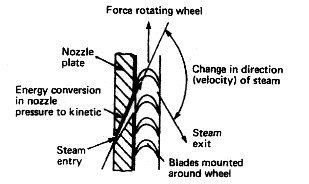
Marine steam turbines operating procedure
The steam turbine has until recently been the first choice for very large
power marine propulsion units. Its advantages of little or no vibration, low
weight, minimal space requirements and low maintenance costs are
considerable. Furthermore a turbine can be provided for any power
rating likely to be required for marine propulsion. However, the higher
specific fuel consumption when compared with a diesel engine offsets
these advantages, although refinements such as reheat have narrowed
the gap.


